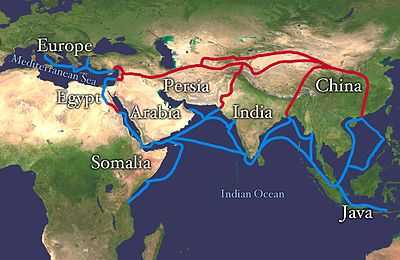Globalization in China
Globalization in China discusses the history of globalization in China; including the economic, social, cultural influences that have been integrated into Chinese society.
Early dynasties and the Silk Road

The first historical instance of China engaging in internationalism was during the Han Dynasty.[1] At the start of the Han Dynasty, the Huns in the north were attacking the frontiers of Han and trying to obtain riches. Emperor Wu of Han wanted to gain an alliance with a country called Dayuezhi so the two countries could join together and fight against the Huns.[2] To obtain this alliance, Emperor Wu sent Zhang Qian to the West to establish economic and cultural connections.[2] History records that during the Han Dynasty there were four primary avenues of contact between China and Europe. They included the northern land route, the central land route, the southern sea route, and the far southern sea route.[1] The most famous of these routes is the central land route, or the classical Silk Road, comprising a network of roads stretching from northwest China to the ports of Syria and the Black Sea, which passed through the oasis of the Turkestans and Northern Persia.[1] The Silk Road was significant for Chinese emperors because it provided dominance over Central Asia by developing resources and provided new markets for the export of China's most valuable resources.[1]
During the Tang Dynasty there was a new age of urbanization and increased maritime commerce.[1] For instance, Changan, the capital of the Dynasty, developed into one of the largest cities during that time.[2] By 742 AD, the population had reached almost 2 million and census showed that 5,000 foreigners lived in the city: Turks, Iranians, Indians, and others from along the road.[2] Trade continued to flourish during this period and brought an increased number of foreigners, foreign religions, and foreign ideas in China.
The Song Dynasty transformed the focus of the Silk Road from the reliance on domestic trade to a reliance on Pacific Orientation. Trade was now supported by a large merchant marine and defended by an imperial navy and long distance routes to the Middle East, India and the coast of Africa were now more readily available.[3] During this period, the government started to heavily regulate foreign trade due to military threats on the Northern border.[1] In order to monitor the flow of commodities in international trade, the Bureau of Merchant Shipping was established to tax merchant ships passing through.[1] In addition, international trade became less focused on cultural exchanges and instead was seen as a necessity for the growth of the Chinese economy.[1]
See also
References
- ↑ 1.0 1.1 1.2 1.3 1.4 1.5 1.6 1.7 Killion, U. (2006) A modern Chinese journey to the west. New York: Nova Science Publishers, Inc.
- ↑ 2.0 2.1 2.2 2.3 Wild, O. (1992). The Silk road. Retrieved from http://www.ess.uci.edu/~oliver/silk.html
- ↑ G. Veeck, C. Pannell, C. Smith and Y. Huang. China’s Geography: Rowman and Littlefield, Lanham MD, 2007